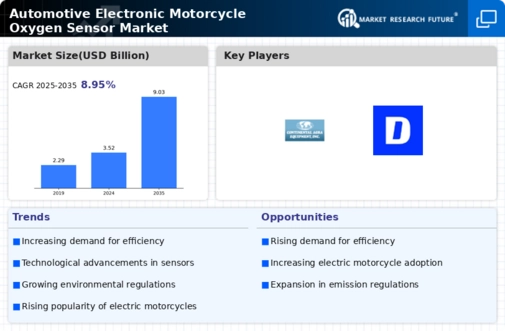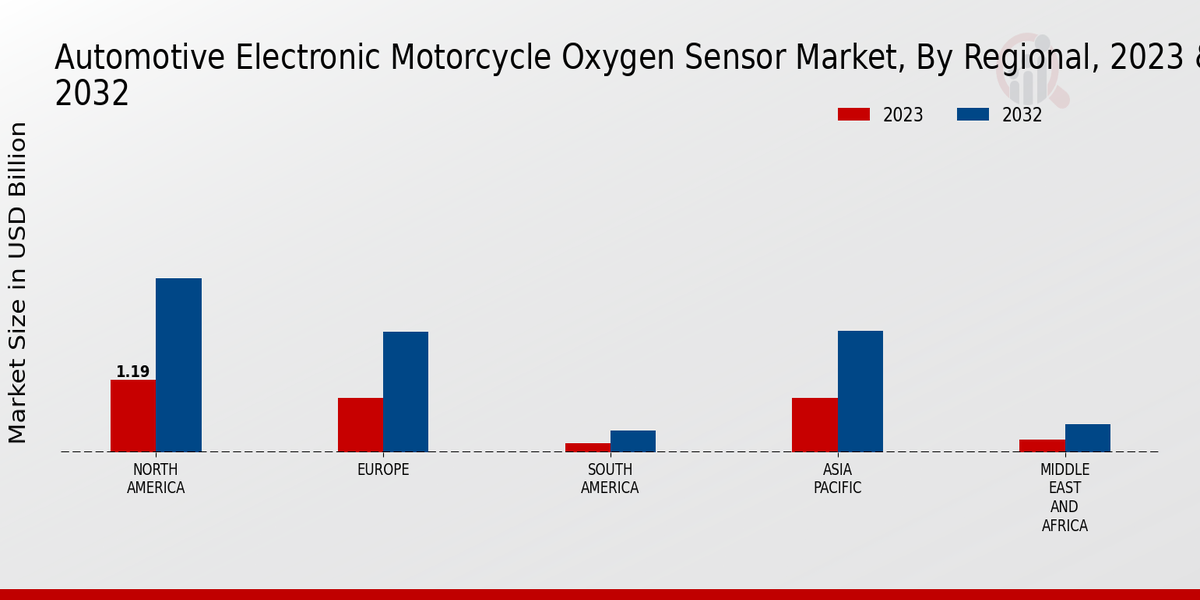Market Growth Projections
The Global Automotive Electronic Motorcycle Oxygen Sensor Market Industry is poised for substantial growth, with projections indicating a market size of 9.03 USD Billion by 2035. This anticipated growth is underpinned by various factors, including technological advancements, increasing motorcycle production, and stringent emission regulations. The compound annual growth rate of 8.94% from 2025 to 2035 suggests a robust expansion trajectory. As manufacturers continue to innovate and enhance their product offerings, the market is likely to attract new entrants and investments. This dynamic environment presents opportunities for stakeholders to capitalize on the evolving landscape of the motorcycle industry.
Stringent Emission Regulations
The Global Automotive Electronic Motorcycle Oxygen Sensor Market Industry is significantly impacted by stringent emission regulations imposed by governments worldwide. Regulatory bodies are enforcing stricter standards to reduce vehicular emissions, compelling manufacturers to integrate advanced oxygen sensors into their motorcycles. For instance, the Euro 5 standards in Europe mandate lower emissions, pushing manufacturers to adopt technologies that enhance combustion efficiency. As a result, the demand for high-quality oxygen sensors is expected to surge, as they are vital for compliance. This regulatory pressure not only drives innovation but also expands the market, as manufacturers seek to meet these evolving standards.
Rising Demand for Fuel Efficiency
The Global Automotive Electronic Motorcycle Oxygen Sensor Market Industry is experiencing heightened demand for fuel-efficient vehicles. As consumers become increasingly aware of environmental issues, manufacturers are compelled to enhance fuel efficiency in motorcycles. Oxygen sensors play a crucial role in optimizing combustion, thereby improving fuel economy. This trend is particularly evident in regions with stringent emission regulations, such as Europe and North America. The market is projected to reach 3.52 USD Billion in 2024, reflecting a growing emphasis on sustainable transportation solutions. Consequently, the integration of advanced oxygen sensors is likely to become a standard feature in new motorcycle models.
Increasing Motorcycle Production and Sales
The Global Automotive Electronic Motorcycle Oxygen Sensor Market Industry is closely linked to the rising production and sales of motorcycles worldwide. With the growing popularity of two-wheelers in emerging economies, manufacturers are ramping up production to meet consumer demand. For example, countries like India and China are witnessing a surge in motorcycle sales, driven by urbanization and a preference for cost-effective transportation. This increase in production directly correlates with the demand for oxygen sensors, as they are essential components for meeting emission standards. The anticipated compound annual growth rate of 8.94% from 2025 to 2035 further illustrates the market's potential as motorcycle sales continue to rise.
Technological Advancements in Sensor Technology
Technological innovations are significantly influencing the Global Automotive Electronic Motorcycle Oxygen Sensor Market Industry. The development of smart sensors equipped with advanced algorithms enhances their accuracy and responsiveness. These innovations facilitate real-time monitoring of exhaust emissions, leading to improved performance and compliance with regulatory standards. For instance, the introduction of wideband oxygen sensors allows for better air-fuel ratio control, which is essential for high-performance motorcycles. As manufacturers increasingly adopt these technologies, the market is expected to grow, with projections indicating a rise to 9.03 USD Billion by 2035. This growth underscores the importance of continuous innovation in sensor technology.
Growing Awareness of Environmental Sustainability
The Global Automotive Electronic Motorcycle Oxygen Sensor Market Industry is benefiting from a growing awareness of environmental sustainability among consumers. As individuals become more conscious of their carbon footprint, there is a noticeable shift towards eco-friendly transportation options. Motorcycles equipped with efficient oxygen sensors contribute to reduced emissions and improved fuel economy, aligning with consumer preferences for sustainable choices. This trend is particularly pronounced in urban areas, where pollution concerns are paramount. Consequently, manufacturers are increasingly focusing on developing motorcycles that meet these sustainability criteria, thereby driving demand for advanced oxygen sensors. This shift in consumer behavior is likely to shape the market landscape in the coming years.














Leave a Comment